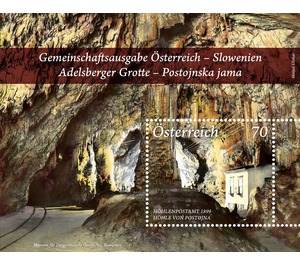joint issues Adelsberg Grotto Slovenia - Austria / II. Republic of Austria 2013
Theme: Science
| Country | Austria / II. Republic of Austria |
| Issue Date | 2013 |
| Edition Issued | 170,000 |
| Item Type | Block |
| Chronological Chapter | OOS-OE2 |
| Chronological Issue Number | Block 73 |
| SID | 856916 |
| In 51 Wishlists | |
The caves of Postojna - German "Adelsberger Grotte", Slovene "Postojnska jama" - form the theme of the new joint issue of Austria and Slovenia. In the karst area around the Slovenian town of Postojna, there are the second largest tourist caves open to tourists in the world. The emergence of the three main levels existing cave system explains the fact that borders on the southwestern edge of the Pivka Basin, the little water-permeable so-called "Eocene flysch" in the underground against mighty limestone layers of chalk, which consist of particularly pure limestone, which in turn is stronger by water is dissolved as the sand and clay stones of the flysch. Dates of the deposited cave sediments showed an age of about 900,000 years. The course of the caves shows two main directions, with a large part running clearly in northwest-southeast direction and thus parallel to tectonic disturbances in the cave area, the other part is approximately perpendicular to it and is much more branched. The first cave visit is occupied in 1213; In 1818, light was first installed, paths were laid and new parts of the cave discovered. Since the completion of the railway Vienna-Ljubljana-Trieste in 1857, the number of visitors increased considerably. The first cave railway started in 1872, locomotives with internal combustion engines were used in 1914, and in 1959 they were replaced by an electric railway. Finally, in 1968, those paths were built that are still in use today and are used by more than half a million visitors every year. Of course, the fact that at the end of the 19th century a post office was set up in the Adelsberg Grotto is quite curious (see motif of the Markenblock). Vouchers of the stamp used there are documented from Whitsuntide 1900 to 1914 on picture postcards. In the post office list of 1901 the "Adelsberger Grotte" is listed under the number 874 Adelsberg (Postojna) with a footnote: "letter reception service on Whit Monday, 15 August, as well as on three to four days of each year." The Teplitzer Zeitung, meanwhile, wrote 9/8/1911: "In this modern grotto, the Austrian Ministry of Commerce has a Kk for the highly developed picture postcard industry Grottenpostamt built and the post office there, which comes from the grotto itself in all directions, provided with its own Grottenpoststempel. For example, to prove the popularity of this institution, let us just mention, for example, that in four hours this year alone, 47,000 postcards weighing 219 kg were taken on the occasion of the Grotto Festival. "- As the war progressed, the cave post office became in March 1915 by the kuk Field post office 81 replaced.


